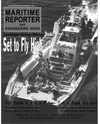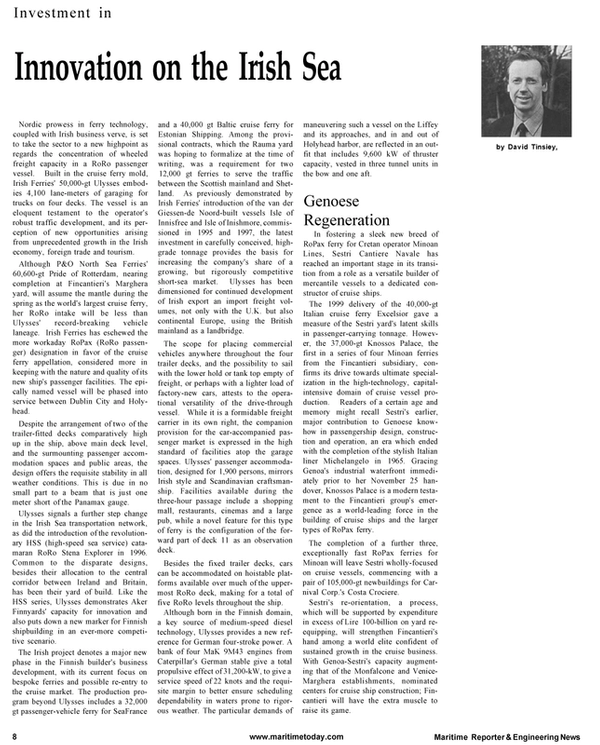
Innovation on the Irish Sea
Nordic prowess in ferry technology, coupled with Irish business verve, is set to take the sector to a new highpoint as regards the concentration of wheeled freight capacity in a RoRo passenger vessel. Built in the cruise ferry mold, Irish Ferries' 50,000-gt Ulysses embodies 4,100 lane-meters of garaging for trucks on four decks. The vessel is an eloquent testament to the operator's robust traffic development, and its perception of new opportunities arising from unprecedented growth in the Irish economy, foreign trade and tourism.
Although P&O North Sea Ferries' 60,600-gt Pride of Rotterdam, nearing completion at Fincantieri's Marghera yard, will assume the mantle during the spring as the world's largest cruise ferry, her RoRo intake will be less than Ulysses' record-breaking vehicle laneage. Irish Ferries has eschewed the more workaday RoPax (RoRo passenger) designation in favor of the cruise ferry appellation, considered more in keeping with the nature and quality of its new ship's passenger facilities. The epically named vessel will be phased into service between Dublin City and Holyhead.
Despite the arrangement of two of the trailer-fitted decks comparatively high up in the ship, above main deck level, and the surmounting passenger accommodation spaces and public areas, the design offers the requisite stability in all weather conditions. This is due in no small part to a beam that is just one meter short of the Panamax gauge.
Ulysses signals a further step change in the Irish Sea transportation network, as did the introduction of the revolutionary HSS (high-speed sea service) catamaran RoRo Stena Explorer in 1996.
Common to the disparate designs, besides their allocation to the central corridor between Ireland and Britain, has been their yard of build. Like the HSS series, Ulysses demonstrates Aker Finnyards' capacity for innovation and also puts down a new marker for Finnish shipbuilding in an ever-more competitive scenario.
The Irish project denotes a major new phase in the Finnish builder's business development, with its current focus on bespoke ferries and possible re-entry to the cruise market. The production program beyond Ulysses includes a 32,000 gt passenger-vehicle ferry for SeaFrance and a 40,000 gt Baltic cruise ferry for Estonian Shipping. Among the provisional contracts, which the Rauma yard was hoping to formalize at the time of writing, was a requirement for two 12,000 gt ferries to serve the traffic between the Scottish mainland and Shetland.
As previously demonstrated by Irish Ferries' introduction of the van der Giessen-de Noord-built vessels Isle of Innisfree and Isle of Inishmore, commissioned in 1995 and 1997, the latest investment in carefully conceived, highgrade tonnage provides the basis for increasing the company's share of a growing, but rigorously competitive short-sea market. Ulysses has been dimensioned for continued development of Irish export an import freight volumes, not only with the U.K. but also continental Europe, using the British mainland as a landbridge.
The scope for placing commercial vehicles anywhere throughout the four trailer decks, and the possibility to sail with the lower hold or tank top empty of freight, or perhaps with a lighter load of factory-new cars, attests to the operational versatility of the drive-through vessel. While it is a formidable freight carrier in its own right, the companion provision for the car-accompanied passenger market is expressed in the high standard of facilities atop the garage spaces. Ulysses' passenger accommodation, designed for 1,900 persons, mirrors Irish style and Scandinavian craftsmanship.
Facilities available during the three-hour passage include a shopping mall, restaurants, cinemas and a large pub, while a novel feature for this type of ferry is the configuration of the forward part of deck 11 as an observation deck.
Besides the fixed trailer decks, cars can be accommodated on hoistable platforms available over much of the uppermost RoRo deck, making for a total of five RoRo levels throughout the ship.
Although born in the Finnish domain, a key source of medium-speed diesel technology, Ulysses provides a new reference for German four-stroke power. A bank of four MaK 9M43 engines from Caterpillar's German stable give a total propulsive effect of 31,200-kW, to give a service speed of 22 knots and the requisite margin to better ensure scheduling dependability in waters prone to rigorous weather. The particular demands of maneuvering such a vessel on the Liffey and its approaches, and in and out of Holyhead harbor, are reflected in an outfit that includes 9,600 kW of thruster capacity, vested in three tunnel units in the bow and one aft.
Read Innovation on the Irish Sea in Pdf, Flash or Html5 edition of January 2001 Maritime Reporter
Other stories from January 2001 issue
Content
- Innovation on the Irish Sea page: 8
- Genoese Regeneration page: 8
- Coast Guard Announces Marine Casually Reporting Requirements page: 9
- $29.9M Approved For U.S. Shipbuilding Loan Guarantees page: 9
- Southern Hospitality page: 10
- Incat Signs Deal With Bollinger page: 10
- Image Marine Delivers Cruise Catamaran for Private Operation page: 14
- Spain Creates Joint European Company page: 15
- Crowley To Acquire MTC page: 15
- Cammell Laird Awaits Costa Crociere Decision page: 16
- Wartsila Puts More Sulzer RTA84T's On Large Tankers page: 17
- NASSCO Lands $68 Million Continuous Maintenance page: 18
- Northrop Grumman To Acquire Litton Industries For $5.IB page: 20
- Finnlines Consolidates, Announces Appointments page: 21
- Svenska Skum Equipment On New Fireboats page: 22
- Eastern Shipbuilding Delivers Newest OSV page: 23
- Ayton Cross Arrives To Boost Wijsmuller Marine's Fleet page: 24
- USS Roosevelt Is Commissioned At Mayport page: 24
- Blount-Barker Shipbuilding Formed page: 26
- New N.C. Ferry-Linked Water Monitoring Generates Data page: 28
- Largest Aquastrada High Speed Ferry Under Construction At Rodriquez page: 29
- Passenger Vessel page: 31
- International Appeal With Local Customer Service Feel page: 33
- German Dry Cargo Division Breaks Into Super Yachts page: 35
- 3-D Modeling For Small And Large Vessel Construction page: 36
- Autostructure - For Ease In The Creation Of Internal Strucutres page: 38
- Proteus Adds Weight Estimating to FlagShip Suite page: 38
- Onstream Project To Optimize FPSO Design page: 40
- Napa Oy Introduces NAPA Steel System For Ship Design page: 40
- EnSolve Biosystems1 Senior Scientist Receives Top Honor page: 41
- The Doctor Is "In" page: 42
- The Natural Order page: 44
- Wartsila Fits First "Smokeless" Diesel page: 50
- Aloha Kittiwake - USCG Welcomes Bollinger-Built Patrol Boats page: 51
- 71 Countries Make IMO's Initial STCW White List page: 53
- NORSHIPCO Receives Enviro Honor page: 53
- New Executive Appointments ATROCL page: 54
- SJS Selected To Build Panama Canal Tugs page: 55
- Halter Marine Awarded $69M Option For Car Carrier page: 55
- Alstom Integrated Controls For Clough Offshore page: 56
- Transas Engine Room Simulators Offer Enhanced Capabilities page: 56
- Boatracs Launches VComm IP page: 57
- Litton European Unit Advances IB Concept For Workboats page: 58


